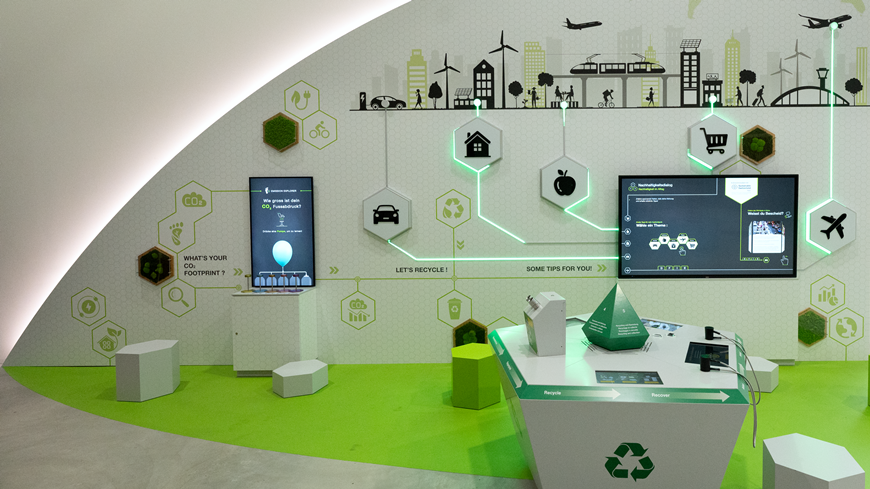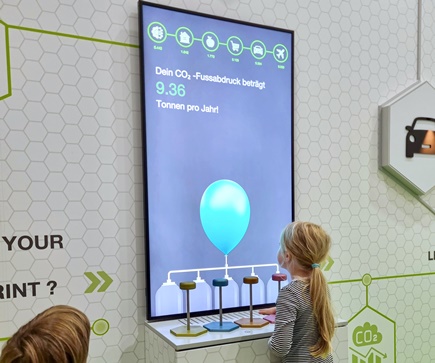Empa research shows individual CO2 footprint
Emission Explorer – a new exhibit at the Swiss Museum of Transport
Net zero: the goal that moves our society at all levels. But what can we as individuals contribute to achieve it? Answers are given by the Emission Explorer, the new exhibit developed by Empa as part of Energy Science for Tomorrow (ES4T), a joint initiative of the ETH Domain and the Swiss Museum of Transport. Visitors can playfully calculate their CO2 emissions and find out in which areas of life they can make a concrete contribution to a more sustainable society.

When you enter the Experience Energy! exhibition at the Swiss Museum of Transport, the first thing you notice is the large globe hanging from the ceiling. It shows in an impressive way how mankind consumes energy worldwide, emits greenhouse gases and thus heats up our planet. The main message of the exhibition quickly becomes clear: In order to preserve our our livelihoods, we must restructure our energy supply as quickly as possible so that we make careful use of renewable energy sources.
A few steps away from the globe, children and adults are fiddling with colorful hand pumps. A balloon inflates on the large screen in front of them. Welcome to the Emission Explorer, the latest exhibit at the Swiss Museum of Transport, which has enjoyed great popularity since its installation at the end of 2024. “When developing the Emission Explorer, our goal was to make the content and design as tangible as possible for the public. Our audience encounters a diverse and high-quality offering at the Museum of Transport. It is therefore all the more important that we also have attractive exhibits on the topics of energy transition and sustainability,” says Alexander Manuzzi, Team Leader Education and Communication and the main person responsible for the Emission Explorer at the Museum of Transport.
One balloon per minute

What seems funny and entertaining at first glance has a serious background: The Emission Explorer calculates how much CO2 each individual lifestyle causes.
Five simple questions on the topics of living, nutrition, consumer behavior, everyday mobility and flight behavior, each with five possible answers, are enough to provide information on how large your own CO2 footprint is, how you compare to the rest of Switzerland as well as to the rest of the world and in which areas of life you have the greatest leverage to reduce your personal emissions.
“The balloon symbolizes our own greenhouse gas emissions,” says Manuzzi. “On average, every Swiss person emits as much CO2 per minute as there is room for in a larger balloon. By answering the questions on the Emission Explorer, you inflate your own CO2 balloon. After the last question, the balloon bursts and air flows towards you. This makes your own emissions not only visible but also tangible.”
«Emission Explorer» at ETH Net Zero Day on May 8, 2025
We are the “system”

Another key goal of the Emission Explorer is to make not only personal CO2 emissions tangible, but also the so-called system share of greenhouse gas emissions. This is because, in addition to individual emissions in the five areas of life, large quantities of CO2 are produced in Switzerland that are beyond our direct individual control. This “system”, which includes industry and infrastructure, for example, produces around 46 million tons of CO2 per year. That's around 5.4 tons per person per year.
“We need to act at all levels of society in order to master the energy transition. The faster we decouple our entire energy system from oil and gas, the sooner our individual footprints will shrink. Of course, this requires cooperation and coordinated action from many people,” says Empa researcher Marcel Gauch, who accompanied the development of the exhibit together with his colleague Martin Gasser and worked out the scientific basis for it. “As an individual, the best way to exert influence here is by regularly voting on energy and climate issues, for example, or campaigning for environmental issues. At the same time, you can immediately and directly reduce your own CO2 emissions by choosing low-CO2 activities and behaviors in the five areas of life covered by the Emission Explorer. In the context of the climate crisis, every kilogram of CO2 avoided counts.”
Science in the museum
The Emission Explorer originates from a joint initiative funded by the ETH Board called Energy Science for Tomorrow (ES4T). The scientific basis of the exhibit is MatCH – a comprehensive analysis of the Swiss economy that Empa carried out on behalf of the Federal Office for the Environment (FOEN) in 2016. The researchers from Empa's Technology and Society laboratory, Marcel Gauch, Cecilia Matasci and Heinz Böni, analyzed all material and energy flows in Switzerland and were thus able to precisely determine the economic sectors and areas of life in which greenhouse gas emissions are generated. In a follow-up scientific publication, they showed the extent to which the various sources of emissions in Switzerland are under the direct or indirect control of an individual.
This complex data was prepared in a summarized and simplified form for the exhibit. “The work on MatCH was very intensive and comprehensive. Since publication, the reports have been cited in various contexts, from the federal administration to industry, science and society,” says Gauch. Now this research is reaching an even wider audience. Since opening at the end of 2024, the Emission Explorer has already registered more than 5,000 interactions. “We hope that this interactive exhibit will continue to be used so enthusiastically over the next three years and inspire many people to find their way to a more sustainable lifestyle,” says Gauch. The Emission Explorer will remain at the Swiss Museum of Transport until 2027.
Emission Explorer – A result of the joint initiative Energy Science for Tomorrow (ES4T)
The Emission Explorer is a result of the joint initiative Energy Science for Tomorrow (ES4T) funded by the ETH Board. Together, ETH Zurich, EPFL, PSI, Empa and the Swiss Museum of Transport are entering into a dialog with the Swiss population in order to identify and address ways to achieve a sustainable energy future with the goal of net zero. By the end of 2026, further exhibits, events and regular workshops on energy and sustainability topics will be developed with the involvement of the public at the Swiss Museum of Transport. More information at: www.energysciencefortomorrow.ch/emission-explorer
Marcel Gauch
Technology & Society
Phone +41 58 765 78 54
Click here for the online «Emission Explorer»-Prototype, with which you can easily calculate your own CO2 footprint.
How much does Switzerland consume? 87 million tons of material each year
MatCH - Material- and energy resources and associated environmental impacts in Switzerland
Emission Explorer: Your system share: More than just CO₂
Energy Science for Tomorrow: A joint initiative of the ETH Domain
C Matasci, M Gauch, H Böni, P Wäger; The Influence of Consumer Behavior on Climate Change: The Case of Switzerland; Sustainability (2021); doi.org/10.3390/su13052966
-
Share






